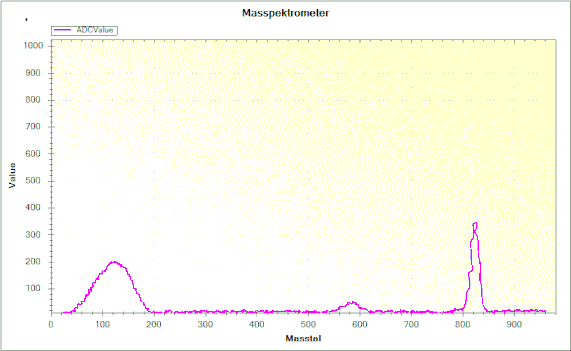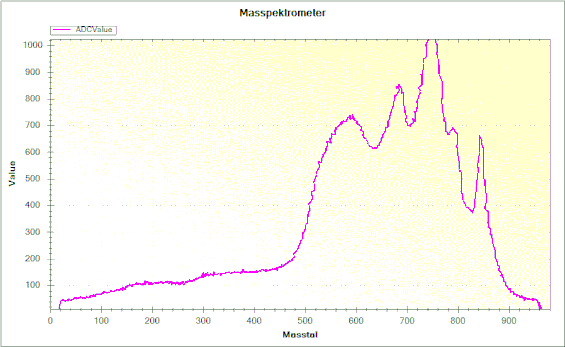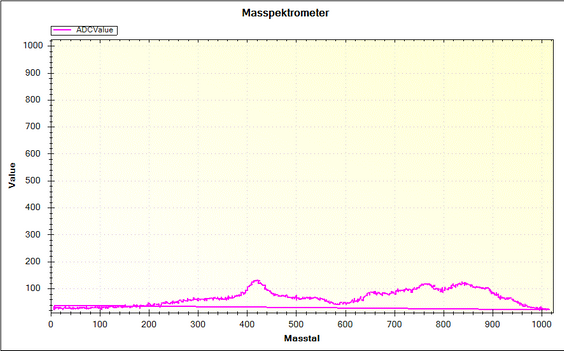Mass spectrograms
These are some spectrograms that I have recorded so far. Unfortunately the x-axis is not in mass units, that is not possible in Megunolink. The mass units are compressed on the x-axis scale towards the higher values. Therefore the peaks are generally more narrow on the right end of the spectrogram.
On the y-axis, "100" corresponds to a partial pressure of about 1 * 10^-5 Torr for that substance. The lowest pressures that I can get in my vacuum system is in the high 10^-6 Torr range.
HYDROGEN, H and H2, HELIUM, He
This is the low mass range of the mass spectrometer.
The peak at 120 is hydrogen atoms, H, at amu 1, the peak at 580 is hydrogen molecules at amu 2. There is almost no hydrogen in air, but there is always some water present in a vacuum system. This reacts with the hot tungsten filament, forming tungsten oxide and free hydrogen as atoms and molecules. This is a well known phenomenon in tungsten lamps, it is the cause of the black tungsten deposit that forms on the glass envelope and erosion over time of the filament. These peaks grow the first minutes after the filament is turned on.
The peak at 820 is helium, He at amu 4,, supplied by me at a leaky tungsten wire glass feed through. The helium atoms are very small and easily penetrates even very small leaks. There is almost no helium in air, so if helium can be detected inside from a source outside of the vacuum system, there is a leak at the position that the helium is supplied.
The helium peak is well defined, and there are no other substances close to this amu, so it works nicely as a leak test.
WATER, NITROGEN, OXYGEN and CARBONDIOXIDE
This is the high mass range of the mass spectrometer.
The peak at 450 is water at amu 18, and the poorly defined peaks to the left of that probably are HO at amu 17 and oxygen atoms at amu 16. The water molecules are broken up into these fragments by the electron bombardment inside the spectrometer. The ratio of water to these fragments will vary somewhat at different occasions.
The peak at 680 is nitrogen N2, at amu 28. The peak at 730 is oxygen, O2, at amu 32. This peak is only partly resolved from the nitrogen peak at amu 28. One would expect the ratio to be 1:4 like it is in air, but the vacuum pump is better at getting rid of the nitrogen, the oxygen tends to stick to the metal surfaces of the vacuum system, as it much more reactive.
There is also a slight peak visible at 840. This is carbon dioxide at amu 44.
This spectrogram is typical of the early pumping down stage, or if there is a large air leak into the vacuum system. The air gasses are dominant at this stage.
ARGON, Ar and CARBON DIOXIDE, CO2
This is a mixture of argon and carbon dioxide injected into the mass spectrometer. This is a gas mixture commonly used for mig welding.
The small peak at 800 is argon at amu 40. The higher peaks at 680 and 740 are nitrogen and oxygen. They slip into the vacuum system through the same leak that I use for injecting the argon/carbon dioxide mix. The sharp peak at 840 is carbon dioxide, amu 44.
The peak at 600 is a mystery, I don´t know what it is. It could possibly be double charged carbon dioxide molecules. If molecules lose two electrons, they will be visible at half the expected amu.
A PUMPED DOWN SYSTEM
After pumping a bit more, the pressure is down at the low 10^-5 Torr range.
At these pressures the water peak at 420 is the dominant one, and the air gas peaks get lower and lower. At the final vacuum of my system, in the high 10^-6 Torr range, they are hardly visible, but a slight water peak is always present, as is the hydrogen H2 peak. The water molecules are very polar, and sticks to all surfaces in the system, and outgasses very slowly.
If there should be a leak in the vacuum system, the air peaks will not go down as they should. I have no leaks in my system that are detectable with helium, so at my lowest attainable pressures the outgassing is the main problem, and the cause is mostly water, according to my spectrograms.
With my system closed, so that the pump does not act upon it, the outgassing corresponds to a pressure rise of about 1 * 10^-5 Torr each five or ten seconds.
FREQUENTLY ASKED QUESTIONS
Paragraphs are the main building blocks of web pages. To change what this one says, just double-click here or hit Edit text. You can change the style here, too. Of course, dragging the text will move the paragraph on the page.
Q. Paragraphs are the main building blocks of web pages. To change what this one says, just double-click here or hit Edit text. You can change the style here, too.
Paragraphs are the main building blocks of web pages. To change what this one says, just double-click here or hit Edit text. You can change the style here, too. Of course, dragging the text will move the paragraph on the page.
Q. Paragraphs are the main building blocks of web pages. To change what this one says, just double-click here or hit Edit text. You can change the style here, too.
Paragraphs are the main building blocks of web pages. To change what this one says, just double-click here or hit Edit text. You can change the style here, too. Of course, dragging the text will move the paragraph on the page.
Q. Paragraphs are the main building blocks of web pages. To change what this one says, just double-click here or hit Edit text. You can change the style here, too.
Paragraphs are the main building blocks of web pages. To change what this one says, just double-click here or hit Edit text. You can change the style here, too. Of course, dragging the text will move the paragraph on the page.
Q. Paragraphs are the main building blocks of web pages. To change what this one says, just double-click here or hit Edit text. You can change the style here, too.
Paragraphs are the main building blocks of web pages. To change what this one says, just double-click here or hit Edit text. You can change the style here, too. Of course, dragging the text will move the paragraph on the page.



